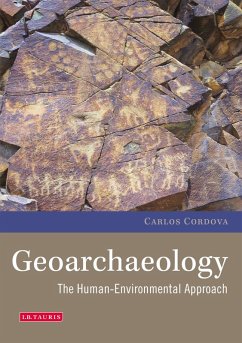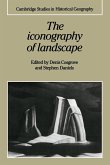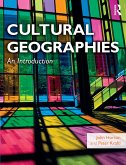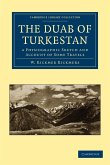- Broschiertes Buch
- Merkliste
- Auf die Merkliste
- Bewerten Bewerten
- Teilen
- Produkt teilen
- Produkterinnerung
- Produkterinnerung
Geoarchaeology is traditionally concerned with reconstructing the environmental aspects of past societies using the methods of the earth sciences. The field has been steadily enriched by scholars from a diversity of disciplines and much has happened as the importance of global perspectives on environmental change has emerged. Carlos Cordova, provides a fully up-to-date account of geoarchaeology that reflects the important changes that have occurred in the past four decades. Innovative features include: the development of the human-ecological approach and the impact of technology on this…mehr
Andere Kunden interessierten sich auch für
![Rural Geography Rural Geography]() Michael WoodsRural Geography77,99 €
Michael WoodsRural Geography77,99 €![The Iconography of Landscape The Iconography of Landscape]() Denis Cosgrove / Stephen Daniels (eds.)The Iconography of Landscape48,99 €
Denis Cosgrove / Stephen Daniels (eds.)The Iconography of Landscape48,99 €![Cultural Geographies Cultural Geographies]() John HortonCultural Geographies115,99 €
John HortonCultural Geographies115,99 €![The Duab of Turkestan The Duab of Turkestan]() Rickmers W. RickmerThe Duab of Turkestan75,99 €
Rickmers W. RickmerThe Duab of Turkestan75,99 €![Urban Utopias Urban Utopias]() Malcolm MilesUrban Utopias56,99 €
Malcolm MilesUrban Utopias56,99 €![Geographies of Mobilities Geographies of Mobilities]() Tim CresswellGeographies of Mobilities67,99 €
Tim CresswellGeographies of Mobilities67,99 €![Methods in Human Geography Methods in Human Geography]() Robin FlowerdewMethods in Human Geography74,99 €
Robin FlowerdewMethods in Human Geography74,99 €-
-
-
Geoarchaeology is traditionally concerned with reconstructing the environmental aspects of past societies using the methods of the earth sciences. The field has been steadily enriched by scholars from a diversity of disciplines and much has happened as the importance of global perspectives on environmental change has emerged. Carlos Cordova, provides a fully up-to-date account of geoarchaeology that reflects the important changes that have occurred in the past four decades. Innovative features include: the development of the human-ecological approach and the impact of technology on this approach; how the diversity of disciplines contributes to archaeological questions; frontiers of archaeology in the deep past, particularly the Anthropocene; the geoarchaeology of the contemporary past; the emerging field of ethno-geoarchaeology; the role of geoarchaeology in global environmental crises and climate change.
Produktdetails
- Produktdetails
- Verlag: I.B. Tauris
- Seitenzahl: 318
- Erscheinungstermin: 20. Februar 2020
- Englisch
- Abmessung: 244mm x 170mm x 17mm
- Gewicht: 552g
- ISBN-13: 9780755606771
- ISBN-10: 0755606779
- Artikelnr.: 58411511
- Herstellerkennzeichnung
- Libri GmbH
- Europaallee 1
- 36244 Bad Hersfeld
- gpsr@libri.de
- Verlag: I.B. Tauris
- Seitenzahl: 318
- Erscheinungstermin: 20. Februar 2020
- Englisch
- Abmessung: 244mm x 170mm x 17mm
- Gewicht: 552g
- ISBN-13: 9780755606771
- ISBN-10: 0755606779
- Artikelnr.: 58411511
- Herstellerkennzeichnung
- Libri GmbH
- Europaallee 1
- 36244 Bad Hersfeld
- gpsr@libri.de
Carlos Cordova is Professor of Geography, Oklahoma State University, USA.
List of figures
List of tables
Introduction
Chapter 1 The nature of geoarchaeology
The nature of geoarchaeology and its practitioners
The three major traditions in geoarchaeology
The field and its status in and outside science
Practice, training, and rapidly evolving subfields
Chapter 2 Theoretical and methodological foundations
Introduction
Theory in geoarchaeology
The geoarchaeological method
Models of inquiry and interpretation
Reconstructing the past
The explanation of a complex and chaotic world
Concluding remarks
Chapter 3 The geoarchaeological record: Concept and contexts
An epistemological background
An all-inclusive geoarchaeological record
The contextual levels: site, setting, landscape and environment
Models of interpretation
Chapter 4 The geoarchaeological record: Interpretation issues
Visualizing time, causality, and context
Causality in natural and cultural transform processes
Time-transgressive phenomena and multi-causal effects
Archaeological visibility, invisibility, and absence
The virtues of off-site geoarchaeology
Legacy effects, relicts, and palimpsests
Modern analogs, reference analogs, and modern references
Sampling and interpretation of the record
Correlation and its issues
Chapter 5 The human-environmental tradition in geoarchaeology
Introduction
The ecological paradigm
The ecological context in geoarchaeology
Geoarchaeology after Archaeology as Human Ecology
The rise of the Anthropocene and global climate change
Perspectives on the anthropic and non-anthropic worlds
Geoarchaeology and environmental history
Chapter 6 Geoarchaeology and human evolution
Introduction
Geology, climate changes, and biogeography
Geoarchaeology in paleoanthropological research
Contextual and issues
Case 6.1 Context and scale in the Olduvai hominin record
Chapter 7 Geoarchaeology and the anthropization of the world
Introduction
The proto-anthropic period as a gray zone
Geoarchaeology and the pre- and proto-anthropic periods
Case 7.1 Between paleontological and archaeological sites:
Geoarchaeological issues in Pre-Clovis mammoth localities
Case 7.2 The geoarchaeology of early Australian human environments at Lake
Mungo
Chapter 8 The geoarchaeology of hunter-gatherer landscapes
Introduction
Hunter-gatherer societies and their environmental contexts
Geoarchaeological approaches to hunter-gatherer landscaapes
Case 8.1 Epipaleolithic hunter-gatherers of the Eastern Levant. Sites,
settings and landscapes in a rapidly changing environment
Case 8.2: The geoarchaeology of the Archaic period in the Great Plains of
North America
Chapter 9 The record of early agriculture and its diffusion
Introduction
Agricultural beginnings: Contextual models
Neolithic impacts at different scales
Geoarchaeological context and research strategies
Case 9.1 Geoarchaeology of two Near Eastern Neolithic settlements: Ain
Ghazal and Ain Abu-Nukhaila, and the first agricultural environmental
crisis
Case 9.2 The elusive environmental impact of the arrival of pastoralism in
Southern Africa.
Chapter 10 Complex societal-environmental systems and the collapse
phenomenon
Introduction
Complex societal-environmental systems
The rise and collapse phenomenon
Research contexts
Case 10.1 Ancient sustainability, risks, management, and centralization in
large river basins: Three examples.
Case 10.2 The Classic Maya collapse and the degradation of soils in the
Maya lowlands: Geoarchaeological models of landscape transformation.
Chapter 11 The geoarchaeology of rural landscapes
Introduction
The rural landscape: concepts and environmental approaches
Geoarchaeological strategies in rural contexts
Case 11.1 The Ancient Greek rural landscape of Crimea
Case 11.2 Xaltocan: The geoarchaeology of a complex lacustrine society
before Tenochtitlan.
Chapter 12 Human-environmental approaches to soils and paleosols
Introduction
Thematic approaches to paleosols
The
List of tables
Introduction
Chapter 1 The nature of geoarchaeology
The nature of geoarchaeology and its practitioners
The three major traditions in geoarchaeology
The field and its status in and outside science
Practice, training, and rapidly evolving subfields
Chapter 2 Theoretical and methodological foundations
Introduction
Theory in geoarchaeology
The geoarchaeological method
Models of inquiry and interpretation
Reconstructing the past
The explanation of a complex and chaotic world
Concluding remarks
Chapter 3 The geoarchaeological record: Concept and contexts
An epistemological background
An all-inclusive geoarchaeological record
The contextual levels: site, setting, landscape and environment
Models of interpretation
Chapter 4 The geoarchaeological record: Interpretation issues
Visualizing time, causality, and context
Causality in natural and cultural transform processes
Time-transgressive phenomena and multi-causal effects
Archaeological visibility, invisibility, and absence
The virtues of off-site geoarchaeology
Legacy effects, relicts, and palimpsests
Modern analogs, reference analogs, and modern references
Sampling and interpretation of the record
Correlation and its issues
Chapter 5 The human-environmental tradition in geoarchaeology
Introduction
The ecological paradigm
The ecological context in geoarchaeology
Geoarchaeology after Archaeology as Human Ecology
The rise of the Anthropocene and global climate change
Perspectives on the anthropic and non-anthropic worlds
Geoarchaeology and environmental history
Chapter 6 Geoarchaeology and human evolution
Introduction
Geology, climate changes, and biogeography
Geoarchaeology in paleoanthropological research
Contextual and issues
Case 6.1 Context and scale in the Olduvai hominin record
Chapter 7 Geoarchaeology and the anthropization of the world
Introduction
The proto-anthropic period as a gray zone
Geoarchaeology and the pre- and proto-anthropic periods
Case 7.1 Between paleontological and archaeological sites:
Geoarchaeological issues in Pre-Clovis mammoth localities
Case 7.2 The geoarchaeology of early Australian human environments at Lake
Mungo
Chapter 8 The geoarchaeology of hunter-gatherer landscapes
Introduction
Hunter-gatherer societies and their environmental contexts
Geoarchaeological approaches to hunter-gatherer landscaapes
Case 8.1 Epipaleolithic hunter-gatherers of the Eastern Levant. Sites,
settings and landscapes in a rapidly changing environment
Case 8.2: The geoarchaeology of the Archaic period in the Great Plains of
North America
Chapter 9 The record of early agriculture and its diffusion
Introduction
Agricultural beginnings: Contextual models
Neolithic impacts at different scales
Geoarchaeological context and research strategies
Case 9.1 Geoarchaeology of two Near Eastern Neolithic settlements: Ain
Ghazal and Ain Abu-Nukhaila, and the first agricultural environmental
crisis
Case 9.2 The elusive environmental impact of the arrival of pastoralism in
Southern Africa.
Chapter 10 Complex societal-environmental systems and the collapse
phenomenon
Introduction
Complex societal-environmental systems
The rise and collapse phenomenon
Research contexts
Case 10.1 Ancient sustainability, risks, management, and centralization in
large river basins: Three examples.
Case 10.2 The Classic Maya collapse and the degradation of soils in the
Maya lowlands: Geoarchaeological models of landscape transformation.
Chapter 11 The geoarchaeology of rural landscapes
Introduction
The rural landscape: concepts and environmental approaches
Geoarchaeological strategies in rural contexts
Case 11.1 The Ancient Greek rural landscape of Crimea
Case 11.2 Xaltocan: The geoarchaeology of a complex lacustrine society
before Tenochtitlan.
Chapter 12 Human-environmental approaches to soils and paleosols
Introduction
Thematic approaches to paleosols
The
List of figures
List of tables
Introduction
Chapter 1 The nature of geoarchaeology
The nature of geoarchaeology and its practitioners
The three major traditions in geoarchaeology
The field and its status in and outside science
Practice, training, and rapidly evolving subfields
Chapter 2 Theoretical and methodological foundations
Introduction
Theory in geoarchaeology
The geoarchaeological method
Models of inquiry and interpretation
Reconstructing the past
The explanation of a complex and chaotic world
Concluding remarks
Chapter 3 The geoarchaeological record: Concept and contexts
An epistemological background
An all-inclusive geoarchaeological record
The contextual levels: site, setting, landscape and environment
Models of interpretation
Chapter 4 The geoarchaeological record: Interpretation issues
Visualizing time, causality, and context
Causality in natural and cultural transform processes
Time-transgressive phenomena and multi-causal effects
Archaeological visibility, invisibility, and absence
The virtues of off-site geoarchaeology
Legacy effects, relicts, and palimpsests
Modern analogs, reference analogs, and modern references
Sampling and interpretation of the record
Correlation and its issues
Chapter 5 The human-environmental tradition in geoarchaeology
Introduction
The ecological paradigm
The ecological context in geoarchaeology
Geoarchaeology after Archaeology as Human Ecology
The rise of the Anthropocene and global climate change
Perspectives on the anthropic and non-anthropic worlds
Geoarchaeology and environmental history
Chapter 6 Geoarchaeology and human evolution
Introduction
Geology, climate changes, and biogeography
Geoarchaeology in paleoanthropological research
Contextual and issues
Case 6.1 Context and scale in the Olduvai hominin record
Chapter 7 Geoarchaeology and the anthropization of the world
Introduction
The proto-anthropic period as a gray zone
Geoarchaeology and the pre- and proto-anthropic periods
Case 7.1 Between paleontological and archaeological sites:
Geoarchaeological issues in Pre-Clovis mammoth localities
Case 7.2 The geoarchaeology of early Australian human environments at Lake
Mungo
Chapter 8 The geoarchaeology of hunter-gatherer landscapes
Introduction
Hunter-gatherer societies and their environmental contexts
Geoarchaeological approaches to hunter-gatherer landscaapes
Case 8.1 Epipaleolithic hunter-gatherers of the Eastern Levant. Sites,
settings and landscapes in a rapidly changing environment
Case 8.2: The geoarchaeology of the Archaic period in the Great Plains of
North America
Chapter 9 The record of early agriculture and its diffusion
Introduction
Agricultural beginnings: Contextual models
Neolithic impacts at different scales
Geoarchaeological context and research strategies
Case 9.1 Geoarchaeology of two Near Eastern Neolithic settlements: Ain
Ghazal and Ain Abu-Nukhaila, and the first agricultural environmental
crisis
Case 9.2 The elusive environmental impact of the arrival of pastoralism in
Southern Africa.
Chapter 10 Complex societal-environmental systems and the collapse
phenomenon
Introduction
Complex societal-environmental systems
The rise and collapse phenomenon
Research contexts
Case 10.1 Ancient sustainability, risks, management, and centralization in
large river basins: Three examples.
Case 10.2 The Classic Maya collapse and the degradation of soils in the
Maya lowlands: Geoarchaeological models of landscape transformation.
Chapter 11 The geoarchaeology of rural landscapes
Introduction
The rural landscape: concepts and environmental approaches
Geoarchaeological strategies in rural contexts
Case 11.1 The Ancient Greek rural landscape of Crimea
Case 11.2 Xaltocan: The geoarchaeology of a complex lacustrine society
before Tenochtitlan.
Chapter 12 Human-environmental approaches to soils and paleosols
Introduction
Thematic approaches to paleosols
The
List of tables
Introduction
Chapter 1 The nature of geoarchaeology
The nature of geoarchaeology and its practitioners
The three major traditions in geoarchaeology
The field and its status in and outside science
Practice, training, and rapidly evolving subfields
Chapter 2 Theoretical and methodological foundations
Introduction
Theory in geoarchaeology
The geoarchaeological method
Models of inquiry and interpretation
Reconstructing the past
The explanation of a complex and chaotic world
Concluding remarks
Chapter 3 The geoarchaeological record: Concept and contexts
An epistemological background
An all-inclusive geoarchaeological record
The contextual levels: site, setting, landscape and environment
Models of interpretation
Chapter 4 The geoarchaeological record: Interpretation issues
Visualizing time, causality, and context
Causality in natural and cultural transform processes
Time-transgressive phenomena and multi-causal effects
Archaeological visibility, invisibility, and absence
The virtues of off-site geoarchaeology
Legacy effects, relicts, and palimpsests
Modern analogs, reference analogs, and modern references
Sampling and interpretation of the record
Correlation and its issues
Chapter 5 The human-environmental tradition in geoarchaeology
Introduction
The ecological paradigm
The ecological context in geoarchaeology
Geoarchaeology after Archaeology as Human Ecology
The rise of the Anthropocene and global climate change
Perspectives on the anthropic and non-anthropic worlds
Geoarchaeology and environmental history
Chapter 6 Geoarchaeology and human evolution
Introduction
Geology, climate changes, and biogeography
Geoarchaeology in paleoanthropological research
Contextual and issues
Case 6.1 Context and scale in the Olduvai hominin record
Chapter 7 Geoarchaeology and the anthropization of the world
Introduction
The proto-anthropic period as a gray zone
Geoarchaeology and the pre- and proto-anthropic periods
Case 7.1 Between paleontological and archaeological sites:
Geoarchaeological issues in Pre-Clovis mammoth localities
Case 7.2 The geoarchaeology of early Australian human environments at Lake
Mungo
Chapter 8 The geoarchaeology of hunter-gatherer landscapes
Introduction
Hunter-gatherer societies and their environmental contexts
Geoarchaeological approaches to hunter-gatherer landscaapes
Case 8.1 Epipaleolithic hunter-gatherers of the Eastern Levant. Sites,
settings and landscapes in a rapidly changing environment
Case 8.2: The geoarchaeology of the Archaic period in the Great Plains of
North America
Chapter 9 The record of early agriculture and its diffusion
Introduction
Agricultural beginnings: Contextual models
Neolithic impacts at different scales
Geoarchaeological context and research strategies
Case 9.1 Geoarchaeology of two Near Eastern Neolithic settlements: Ain
Ghazal and Ain Abu-Nukhaila, and the first agricultural environmental
crisis
Case 9.2 The elusive environmental impact of the arrival of pastoralism in
Southern Africa.
Chapter 10 Complex societal-environmental systems and the collapse
phenomenon
Introduction
Complex societal-environmental systems
The rise and collapse phenomenon
Research contexts
Case 10.1 Ancient sustainability, risks, management, and centralization in
large river basins: Three examples.
Case 10.2 The Classic Maya collapse and the degradation of soils in the
Maya lowlands: Geoarchaeological models of landscape transformation.
Chapter 11 The geoarchaeology of rural landscapes
Introduction
The rural landscape: concepts and environmental approaches
Geoarchaeological strategies in rural contexts
Case 11.1 The Ancient Greek rural landscape of Crimea
Case 11.2 Xaltocan: The geoarchaeology of a complex lacustrine society
before Tenochtitlan.
Chapter 12 Human-environmental approaches to soils and paleosols
Introduction
Thematic approaches to paleosols
The








